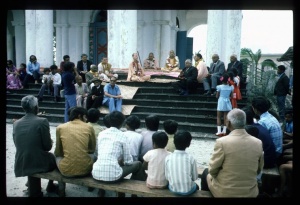CC Madhya 20.346 (1975): Difference between revisions
(Vanibot #0027: CCMirror - Mirror CC's 1996 edition to form a basis for 1975) |
(Vanibot #0020: VersionCompareLinker - added a link to the Version Compare feature) |
||
| Line 2: | Line 2: | ||
<div style="float:left">'''[[Sri Caitanya-caritamrta (1975)|Śrī Caitanya-caritāmṛta (1975)]] - [[CC Madhya (1975)|Madhya-līlā]] - [[CC Madhya 20 (1975)|Chapter 20: Lord Śrī Caitanya Mahāprabhu Instructs Sanātana Gosvāmī in the Science of the Absolute Truth]]'''</div> | <div style="float:left">'''[[Sri Caitanya-caritamrta (1975)|Śrī Caitanya-caritāmṛta (1975)]] - [[CC Madhya (1975)|Madhya-līlā]] - [[CC Madhya 20 (1975)|Chapter 20: Lord Śrī Caitanya Mahāprabhu Instructs Sanātana Gosvāmī in the Science of the Absolute Truth]]'''</div> | ||
<div style="float:right">[[File:Go-previous.png|link=CC Madhya 20.345 (1975)|Madhya-līlā 20.345]] '''[[CC Madhya 20.345 (1975)|Madhya-līlā 20.345]] - [[CC Madhya 20.347 (1975)|Madhya-līlā 20.347]]''' [[File:Go-next.png|link=CC Madhya 20.347 (1975)|Madhya-līlā 20.347]]</div> | <div style="float:right">[[File:Go-previous.png|link=CC Madhya 20.345 (1975)|Madhya-līlā 20.345]] '''[[CC Madhya 20.345 (1975)|Madhya-līlā 20.345]] - [[CC Madhya 20.347 (1975)|Madhya-līlā 20.347]]''' [[File:Go-next.png|link=CC Madhya 20.347 (1975)|Madhya-līlā 20.347]]</div> | ||
{{CompareVersions|CC|Madhya 20.346|CC 1975|CC 1996}} | |||
{{RandomImage}} | {{RandomImage}} | ||
==== TEXT 346 ==== | ==== TEXT 346 ==== | ||
| Line 11: | Line 10: | ||
<div class="verse"> | <div class="verse"> | ||
:dhyāyan kṛte yajan yajñais | :dhyāyan kṛte yajan yajñais | ||
:tretāyāṁ dvāpare | :tretāyāṁ dvāpare 'rcayan | ||
:yad āpnoti tad āpnoti | :yad āpnoti tad āpnoti | ||
:kalau saṅkīrtya keśavam | :kalau saṅkīrtya keśavam | ||
| Line 20: | Line 19: | ||
<div class="synonyms"> | <div class="synonyms"> | ||
dhyāyan—meditating; kṛte—in Satya-yuga; yajan—worshiping; yajñaiḥ—by the performance of great sacrifices; tretāyām—in Tretā-yuga; dvāpare—in Dvāpara-yuga; arcayan—worshiping the lotus feet; yat—whatever; āpnoti—is achieved; tat—that; āpnoti—is obtained; kalau—in the Age of Kali; saṅkīrtya—simply by chanting; keśavam—the pastimes and qualities of Lord Keśava. | dhyāyan—meditating; kṛte—in the Satya-yuga; yajan—worshiping; yajñaiḥ—by the performance of great sacrifices; tretāyām—in the Tretā-yuga; dvāpare—in the Dvāpara-yuga; arcayan—worshiping the lotus feet; yat—whatever; āpnoti—is achieved; tat—that; āpnoti—is obtained; kalau—in the Age of Kali; saṅkīrtya—simply by chanting; keśavam—the pastimes and qualities of Lord Keśava. | ||
</div> | </div> | ||
| Line 27: | Line 26: | ||
<div class="translation"> | <div class="translation"> | ||
" 'Whatever is achieved by meditation in Satya-yuga, by the performance of yajña in Tretā-yuga or by the worship of Kṛṣṇa's lotus feet in Dvāpara-yuga is also obtained in the Age of Kali simply by chanting and glorifying Lord Keśava.' | |||
</div> | </div> | ||
Latest revision as of 13:20, 27 January 2020
Śrī Caitanya-caritāmṛta (1975) - Madhya-līlā - Chapter 20: Lord Śrī Caitanya Mahāprabhu Instructs Sanātana Gosvāmī in the Science of the Absolute Truth

His Divine Grace
A.C. Bhaktivedanta Swami Prabhupada
A.C. Bhaktivedanta Swami Prabhupada
TEXT 346
- dhyāyan kṛte yajan yajñais
- tretāyāṁ dvāpare 'rcayan
- yad āpnoti tad āpnoti
- kalau saṅkīrtya keśavam
SYNONYMS
dhyāyan—meditating; kṛte—in the Satya-yuga; yajan—worshiping; yajñaiḥ—by the performance of great sacrifices; tretāyām—in the Tretā-yuga; dvāpare—in the Dvāpara-yuga; arcayan—worshiping the lotus feet; yat—whatever; āpnoti—is achieved; tat—that; āpnoti—is obtained; kalau—in the Age of Kali; saṅkīrtya—simply by chanting; keśavam—the pastimes and qualities of Lord Keśava.
TRANSLATION
" 'Whatever is achieved by meditation in Satya-yuga, by the performance of yajña in Tretā-yuga or by the worship of Kṛṣṇa's lotus feet in Dvāpara-yuga is also obtained in the Age of Kali simply by chanting and glorifying Lord Keśava.'